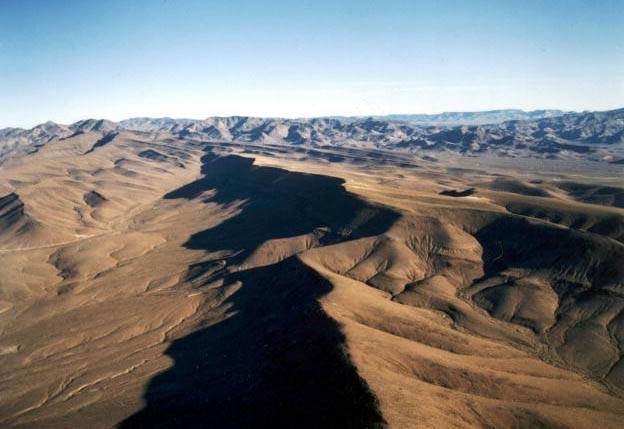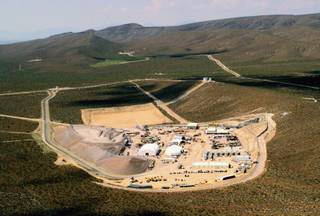
U.S. Department of Energy
Yucca Mountain is located about 90 miles northwest of Las Vegas.
Sunday, Feb. 7, 2010 | 2 a.m.
Related story
- The phone call that would bury dump plan (2-6-2010)
FOR SALE: MOUNTAIN, PRE-DRILLED
The planned closure of the Yucca Mountain nuclear dump project allows an opportunity to ponder a different future for the place. Serious suggestions have included using the site as a long-term research facility or for weapons testing.
On the other hand, maybe Vice President Joe Biden can finally get his own “undisclosed location” or Zappos.com, the huge Internet retailer, could turn it into a really, big warehouse.
Other suggestions include:
- “Maybe it would be a good spot for a new brothel.” -- Mayor Oscar Goodman
- “There are a lot of extra grapes in Napa this year that need to be stored.” -- Bruce Breslow, executive director of the Nevada Agency for Nuclear Projects
- “I bet you could grow mushrooms in there.” -- Dan Burns, spokesman for Gov. Jim Gibbons and former public information officer for Yucca Mountain Waste Repository
- “They should do tours for kids and seniors. You could use the school buses that aren’t used during the day and take people out to Yucca Mountain to go down the tunnels. They already have rail tracks inside, so you just need a few rail cars and you’re set.” -- Anita Kramer, longtime Las Vegas Sun reader
- “Ask the Western Shoshone. It’s a sacred site to them and it’s their land under their treaty with the U.S.” -- Judy Treichel, executive director of the Nevada Nuclear Waste Task Force
- “From our perspective they’re all trespassing.” -- Ian Zabarte, Shoshone member
Sun coverage
Sun archives
- Feds file request for suspension of Yucca Mountain license (2-1-2010)
- Obama to zero out Yucca Mountain funding, pull license (1-31-2010)
- Dying Yucca Mountain still has some life (1-30-2010)
- Obama administration: ‘We’re done with Yucca’ (1-29-2010)
- Friday announcement will unveil plans for panel on Yucca alternatives (1-28-2010)
- White House, Energy Department clash over Yucca Mountain cuts (1-14-2010)
- Report: Yucca Mountain costs double other alternatives (12-2-2009)
- Nuclear industry weighs in on nuke dump license (11-16-2009)
- In Nevada, nuclear raises touchy issues (11-14-2009)
- Feds to slash Yucca funds as project maintains life (11-9-2009
- 3 Las Vegans join state Commission on Nuclear Projects (11-5-2009)
When it was on the drawing boards, the Yucca Mountain radioactive waste dump promised unprecedented challenges to nuclear engineers and physicists: How to safely store nuclear waste underground?
Now with the project being killed by President Barack Obama, the site will offer unprecedented challenges to desert ecologists: How to bring vegetation back to the mountain?
The task is both simple and overwhelming:
Under federal law, the Energy Department has to return the mountain landscape to a state similar to how the agency found it.
That’s easier said than done, because fully restoring a desert landscape can take centuries, or millennia.
Although desert landscape restoration has been attempted with varying degrees of success in recent years, there has never been a desert reclamation project of this size and type.
The Energy Department had not anticipated having to exercise the plan until the waste dump had been filled with spent but still highly radioactive fuel rods from nuclear power plants and shut tight more than 100 years from now.
But after more than 20 years of planning, engineering and design for nuclear waste storage, the department must abruptly change focus to how to restore the mountain.
The department will have to comply with regulations contained in the National Environmental Policy Act, the Federal Land Policy and Management Act, the Clean Air Act, the Endangered Species Act, the Atomic Energy Act and statutes regulating Bureau of Land Management right-of-way agreements.
And after years of geological and seismic tests and the drilling of a gigantic tunnel, there is a lot of damage to repair.
The restoration won’t be considered successful until at least 60 percent of the plant life that existed in 1987, when the agency claimed the site, has been restored.
The Energy Department doesn’t have a final plan for remediating the damage on the mountain, but it has revealed the type of work it had intended to do once the dump was filled.
The Reclamation Implementation Plan took more than 17 years and four revisions to develop. That document includes plans for massive cleanup and replanting efforts at Yucca Mountain.
It is expected to be the foundation for the final plan.
The plan doesn’t discuss what to do with a giant empty tunnel, but does outline how the outer layers of Yucca Mountain could be restored.
The reclamation starts with filling the more than 300 bore holes and numerous trenches and pits dug for hydrology and geology tests, along with tearing down all permanent and temporary buildings, wells and most of the roads. (BLM will have the option of keeping the roads on its land.)
But removing stuff is one thing; getting desert plants to grow in their place is another.
Desert soils and vegetation are fragile, and once severely disturbed, they can take anywhere from many decades to millennia to recover, according to UNLV restorative ecologist Scott Abella, who is wrapping up a study on how long it takes desert ecosystems to recover from disturbances.
His research shows that desert scars, if left to treat themselves, take much longer to heal than most people realize.
Without massive reclamation efforts, it can take at least 100 years for a plant community to begin to recover from the type of bulldozing, soil scraping and building that occurred at Yucca Mountain.
Planting or seeding native vegetation and manipulating the soil, as the Energy Department plans to do, have been shown to speed up recovery, but only if you get lucky and plant the right vegetation in the right year and get the right weather.
Desert reclamation is more trial and error than exact science.
But after studying numerous desert reclamation projects, the Energy Department thinks it has the right formula:
• Recontour the land to mimic original state and “blend into the natural topography of the area.”
• Restore drainage washes and stabilize the earth to reduce erosion.
• Create a seedbed (basically by puncturing compacted earth so seeds can be planted) and water catchment basins in which to plant.
• Test and replace the topsoil.
• Replant native vegetation (via seeds and transplants) in disturbed sites from October to December.
• Mulch the emerging plants with straw to hold in moisture.
• Fence in emerging plants and saplings with chicken wire.
These steps have proved to be effective in the past, at least individually or in pairings. But the Yucca plan is to do it all, and do it relatively quickly. The Energy Department did not answer questions about how long such restorations efforts would take, but the number that has been floating around hearings is two years for upfront work.
That may be overly optimistic.
The restoration would entail a complete rebuilding of a complex plant system over hundreds of acres. It will be unprecedented in both size and scope.
Most desert restoration work has been designed to “visually erase” the disturbance quickly, within 10 years, Abella said.
And even that doesn’t produce quick results.
Every study Abella found had at least one seeding or planting fail outright and have to be redone. Planting success rates averaged about 50 percent.
That’s because many factors that make desert plants grow slowly also can make them not grow at all.
The right weather for germinating seeds occurs only about once a decade. Planting or transplanting often works better, but only for certain plants. It’s also more expensive. And through it all enough rain is needed to keep seedlings and saplings alive through their first summer.
“Even if everything is done right and there is adequate rainfall, desert restoration still can probably only be classified as ‘risky,’ ” Abella said.
The Energy Department doesn’t appear to have much choice. It faces lawsuits and sanctions if the restoration is abandoned.
It’s a project many people, from state officials to local ecologists, will be watching.
It’s believed to be the first project to attempt to restore large tracts of highly disturbed land to anything resembling the original ecosystem.
Recontouring and planting areas will likely hasten the recovery time, but it will still be probably 30 years — possibly longer — before the land looks anything like it did before the Energy Department started drilling. And the department has to regularly assess and monitor the success of its endeavor.
Returning the entire ecosystem to its original state could take even longer.
“Our current technology makes the complete and rapid restoration of the desert unrealistic, but if done well and if done well with rainfall, restoration of soil and vegetation in an area like Yucca Mountain can potentially jump-start and accelerate natural recovery of the desert,” Abella said.


Join the Discussion:
Check this out for a full explanation of our conversion to the LiveFyre commenting system and instructions on how to sign up for an account.
Full comments policy